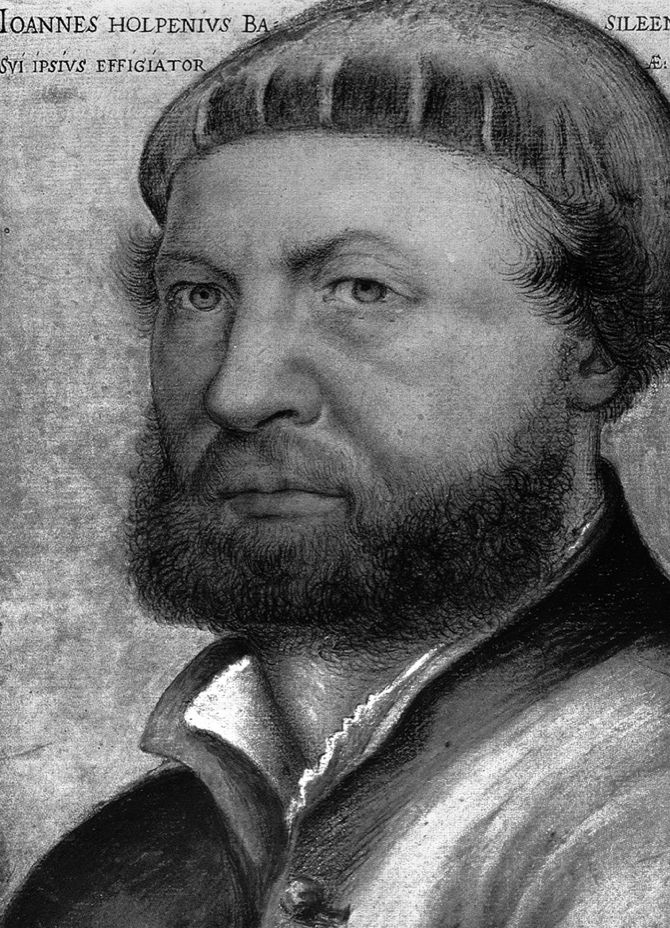Home
Artists
Hans Holbein the Younger
Hans Holbein the Younger
Hans Holbein the Younger was the celebrated artist who immortalised the Tudor aristocracy, and some of the most prominent humanists and intellectuals across Renaissance Europe. Working across paintings, prints, miniatures and jewellery designs, it is as a portraitist that Holbein is best known today. Works such as ‘The Ambassadors’ (1533) showcase not only his technical mastery but are laden with symbolic details, revealing the intellectual, religious and political ideas of his age and sitters. Holbein combined the Northern European tradition with trends from the Italian Renaissance, elevating the genre of portraiture to new heights, as one of the most influential artists of the Northern Renaissance.

Interested in Hans Holbein the Younger?
About the Artist
Hans Holbein the Younger was the celebrated artist who immortalised the Tudor aristocracy, and some of the most prominent humanists and intellectuals across Renaissance Europe. Working across paintings, prints, miniatures and jewellery designs, it is as a portraitist that Holbein is best known today. Works such as ‘The Ambassadors’ (1533) showcase not only his technical mastery but are laden with symbolic details, revealing the intellectual, religious and political ideas of his age and sitters. Holbein combined the Northern European tradition with trends from the Italian Renaissance, elevating the genre of portraiture to new heights, as one of the most influential artists of the Northern Renaissance.
The German painter was born in Augsburg around 1465 into a family of artists. His father was Hans Holbein the Elder, known for his religious paintings of the late Gothic style, and his brother Ambrosius, with whom he collaborated in the first years of his career, was also an accomplished painter. In the early years of the 16th century, Holbein and his brother travelled through Europe to learn their craft. They moved first to Basel, a hub of the printing trade, where were apprenticed to the city’s leading painter, Hans Herbster. In Basel, Holbein received his first important commission: a set of pen drawing illustrations for the influential philosophical treatise In ‘Praise of Folly’ by Erasmus of Rotterdam in 1515. He continued to grow his reputation in humanist and civic circles through portraits, altarpieces murals and book illustrations. The medium of print spread his work, through influential woodcut series like ‘Dance of Death’, and the titlepage to Martin Luther’s Bible.
In 1523, Holbein painted his first portraits of the great Renaissance scholar Erasmus, who required likenesses to send to his friends and admirers throughout Europe. These paintings helped forge his reputation abroad. Holbein first travelled to the English court between 15262 and 1528, on the recommendation of Erasmus. There, he found fame for evocative likenesses of politicians and philosophers such as Sir Thomas More (1527). Likely seeking solace from the religious upheaval of Reformation Basel, he returned to England in 1532. In 1533, Holbein completed what is perhaps his most important work, ‘The Ambassadors’, which portrays two French dignitaries sent to England, a cryptic painting in which symbolic objects allude to their identities, beliefs, wealth and social status.
Having obtained the patronage of Queen Anne Boleyn and the courtier Thomas Cromwell, in 1535 he became the official court painter for King Henry VIII, producing not only portraits but also festive decorations, frescoes and designs for jewellery and precious objects. His artworks document court life during the foundation of the Church of England, established by Henry VIII in opposition to the Roman papacy. He died in England in 1543, likely due to the plague or an infection.
While he is thought to have trained no pupils, his work immediately became cited in his lifetime and after as the model of skilful portraiture. The stylised portraits of the Elizabethan court contrast with Holbein's intensely observed art, yet he played an undeniable role in elevating the genre of portraiture, revealing its symbolic potential. In later centuries, Holbein became a sought-after name for collectors, and a vital inspiration for artists. Holbein's portraits of Renaissance aristocrats and intellectuals continue to bring these figures palpably before our eyes, rendering the past immediate.


